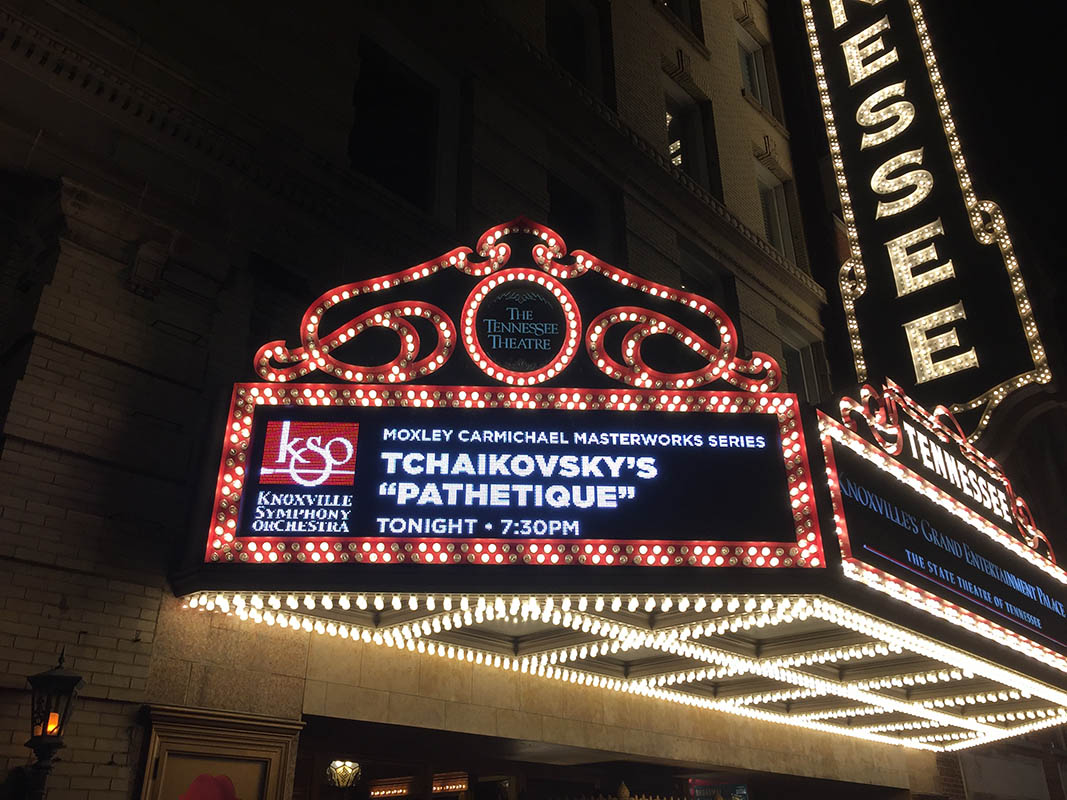The fall Masterworks season for the Knoxville Symphony Orchestra has been an exploration of the colors of emotion in its various forms. Elgar’s Enigma Variations from the September concert described characters and toyed with our heartstrings, while October’s Symphonie Fantastique of Berlioz was the composer’s own dramatic programmatic journey bordering on romantic obsession. A logical next step, then, had to be the music of Tchaikovsky, a composer who communicated through emotional melodies and instrumental colors. In the case of the past weekend’s concerts, the Tchaikovsky work chosen was the Sixth Symphony, nicknamed the “Pathétique.” On the same concert came more color and emotion: the World Premiere of Watercolors by Dosia McKay and Alexander Scriabin’s marvelous, but rarely performed Piano Concerto.
In his introduction to Tchaikovsky’s Sixth on this weekend’s KSO concerts, Resident Conductor James Fellenbaum offered a clarifying point on the work’s nickname, the Pathétique. Fellenbaum was quick to mention that the original Russian word given was patetichesky, a word that carries a very subtle connotation more like passionate or emotional. This stands as a bit of a contrast to the English pathetic and the French pathétique—although both words, and similar words in other European languages, all hark back to the Greek pathos, meaning “suffering.” Music, though, speaks its own language, and one simply cannot escape the idea of suffering in a work that begins and ends with the ultimate lament, even though that dark suffering is modulated in between with both soft and fiery melodies of great beauty.
Fellenbaum often conducts without a score, and that was the case here in the Tchaikovsky. Thus unshackled, he was free to suggest to the orchestra the “passion” that the work elicits. Fellenbaum is a demonstrative conductor and in this work his body language was emotionally suggestive to the audience, as well as to the players. The resulting performance had convincing dramatic power that was a product of lush strings providing the fabric, and woodwinds and brass providing the musically embossed textures.
The four movements stood apart distinctly with the second and third having an energy of optimism and movement that suggests some of the composer’s other work. The second Allegro con grazia features a reminiscent waltz feel, but one with a slightly off-putting 5/4 meter. It was probably totally unnecessary for Fellenbaum to suggest applause after the dizzying third movement (Allegro molto vivace) as it simply is one of those rousing, bold endings that practically insists on an audience response, particularly from the unwary.
It goes without saying, though, that the real and true emotion of the work lies in the first and fourth movements. After the dark and slow opening with the bassoon and double basses that is then taken up with similar darkness in the rest of the orchestra, the principal theme of gorgeous Tchaikovsky lyricism was a welcome relief. The end of the fourth movement, following melodies that suggest hope and possibility, returned to that dark place and then died away into nothingness, an almost imperceptible, silent lament-like finale that Fellenbaum held for as long as the audience could tolerate before bursting into appreciative applause for the excellent performance.
Local music audiences generally know the story of the Russian-born pianist/composer Sergei Rachmaninoff performing for the last time before his death in Knoxville in 1943. While it was Rachmaninoff’s friend and contemporary, Alexander Scriabin, who was on the KSO program this weekend with his only Piano Concerto, those into connections of the two, musical and otherwise, had a field day. Scriabin was but a year older, both composers studied at the Moscow Conservatory at roughly the same time, and both became notable both as pianists and as composers for the piano. Listeners might also find similarities in the lush Romanticism of thematic material in both of their works around the turn of the 20th Century. Of course, all of Rachmaninoff’s piano concertos have fared better with history and audiences than the Scriabin has. Admittedly, this early Scriabin work has brilliant moments of tone, texture, and sparkle, but often seems a jumble of themes and melodies that impress in the short term, but sometimes wander a bit in the grand scheme.
Thankfully, it was pianist Andrew Staupe that joined Fellenbaum and the orchestra for the Scriabin. I’m guessing that the Concerto is a favorite of Staupe’s, because he lavished the work with plenty of boldness and intelligence, and expertly brought clarity, solidity, sparkle, and a sense of style to the thematic passages.
When the piano enters in the second movement, an Andante that is a theme and variations, the substance has become more direct and the mood has mostly changed to wistfulness, with Fellenbaum and the orchestra providing a textural base for the intriguing character of the variations.
With the final movement, Staupe and Fellenbaum masterfully tackled the return to Russian lyricism that seemed to alternate energetic chords with glistening and fluid keyboard sparkle. In the orchestra, the statements of major/minor optimism/conflict resolve at just the right moment, as Staupe’s piano provides the final underlying tonal coloration.
In his opening comments, Fellenbaum had mentioned the evening’s sub-theme of “the colors and conversations of melody.” That concept certainly applied to the opening work of the evening, Watercolors (World Premiere), by Dosia McKay. The composer’s paintings—painterly images that are both impressionistic and abstract—offer a clue as to her concept in Watercolors. The work which was an intriguing and obviously delightful feast for the KSO players offers the listener musical impressions that are a satisfying mixture of intent and surprise—truly a “sonic canvas” as the composer suggests.








